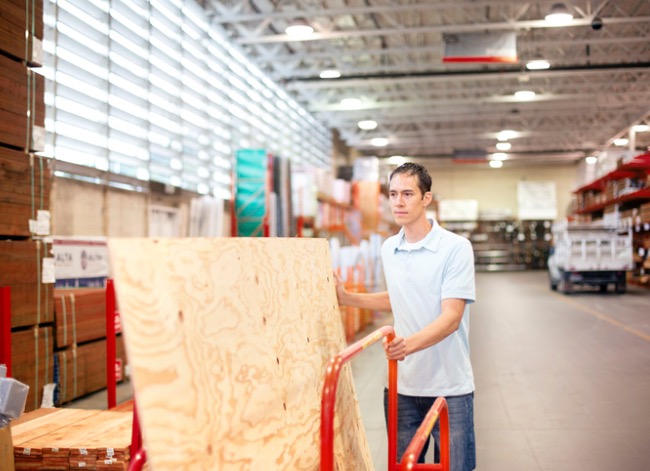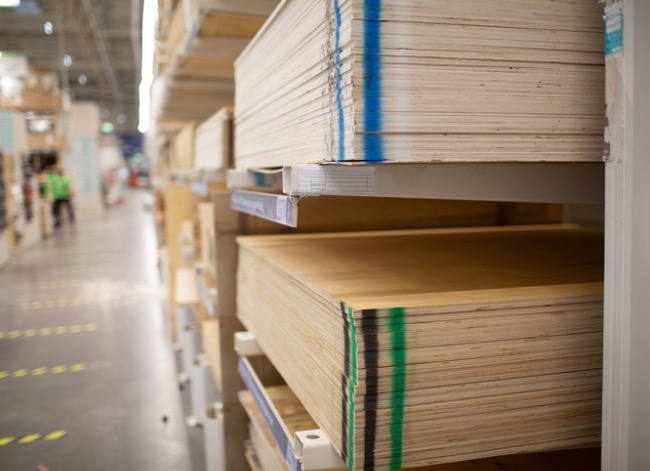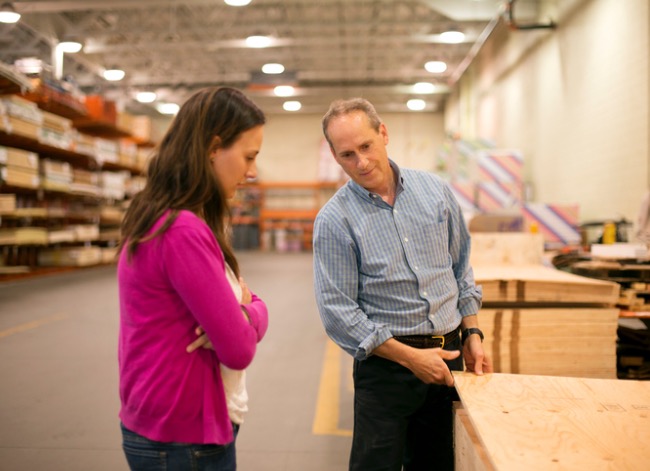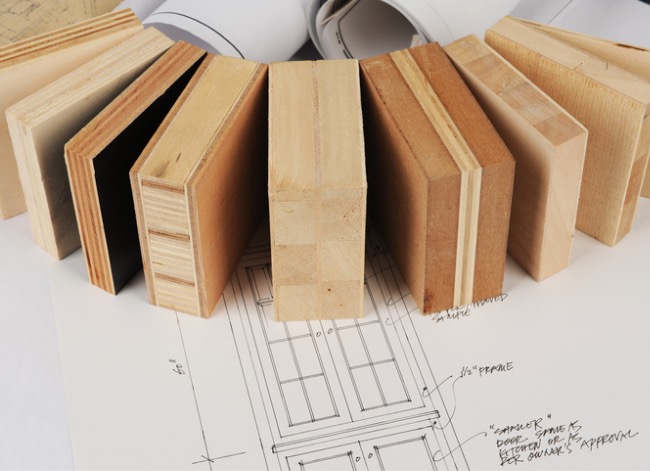

We may earn revenue from the products available on this page and participate in affiliate programs. Learn More ›
A manmade material prized for its great versatility, plywood appears in elements of the home as varied as flooring, walls, doors, and furniture. Strong and lightweight—the product of several compressed, glued-together layers—plywood costs considerably less than solid wood.
In a few important ways, plywood also offers performance that’s superior to that of wood. Plywood’s composition makes it less vulnerable to moisture, and it resists the temperature fluctuations and changes in humidity that sometimes stress natural wood to the point of splitting, cracking, or otherwise degrading.
1. Most—but not all—types of plywood are made out of wood and glue.
Different types of plywood contain different numbers of layers, or plies, with three being the minimum. Typically, one side of the panel—its face—may be left unfinished. The back side is less pleasing to the eye. Of all the many types available, veneer-core plywood is best for holding screws, hinges, and other forms of hardware. Note that some types of plywood actually have a foam rubber core, which enables them to function as insulation against both weather and sound.
2. There are 16 plywood grades, ranging from A1 to D4.
When contractors and do-it-yourselfers mention plywood grades, they are referencing two separate measures: one for the face of the panel, another for its back side. Plywood faces are graded on a scale from A to D, while backs are graded on a scale from 1 to 4. Thus, A1 plywood boasts top quality on both sides. A4, on the other hand, features a quality face but is likely to show defects or discoloration on its back. You can expect plywood grades to be stamped visibly on the sheets.

3. One of the most common forms of plywood is 3-ply, but there are such things as 5-ply, 7-ply, 9-ply, and even 13-ply plywood.
The more plies a sheet of plywood has, the more strength and stability it will exhibit.
- Three-ply sheets are usually very thin and flexible, but don’t provide much strength.
- Five-ply sheets are a bit thicker, and they’re also stronger but light and affordable enough for sheathing houses and roofs.
- Plywood with seven plies or more is typically around ¾-inch thick, but it varies based on the thickness of each ply (which varies by manufacturer). These sheets are very strong but also heavy. They are typically used for applications like subflooring, cabinetmaking, and furniture.
4. Even thin plywood is made of a minimum of three layers, or “plies,” of wood.
Each layer or ply of wood adds strength and stability to the sheet. Manufacturers orient the layers so the long grain of each ply is running perpendicular to the plies above and below them. For that reason, even the thinnest sheets need at least three layers to give the sheet ample strength and appearance.
5. There’s really no such thing as “cabinet-grade plywood.”
The lumber grading industry doesn’t have a designation for “cabinet-grade plywood,” so although the term is popular, it’s not a real thing. Instead, this moniker is referring to hardwood plywood, which typically has a finely sanded side known as the A side, and a slightly less sanded side known as the B side. AB hardwood plywood is strong and expensive, but ideal for cabinetmaking.
6. Plywood sheet sizes are standardized.
Just like most building materials, plywood sheet sizes are standardized in length and height. For instance, almost all structural plywood sheets are 4 feet wide. This allows them to fit easily in the back of a truck or on a store shelf while also being wide enough to span four studs framed 16 inches on-center.
As for length, plywood sheets are almost always 8 feet long (though 10-foot and 12-foot lengths do exist). An 8-foot sheet can span 8 studs framed 16 inches on-center. These standardized sizes make estimating, transporting, and correctly using plywood easier.
7. Plywood thickness can vary a bit from its stated measurement.
Pay special attention to plywood thickness: There is often a 1/32-inch discrepancy between the stated measurement and the actual one. This occurs for several reasons, including sanding after the plies are laminated together, glue thicknesses, or even changes in atmospheric conditions. A scant 1/32 of an inch is rarely an issue aside from fine furniture making, and it can add up over a bank of cabinets.
8. You should always inspect plywood before purchasing it.
When selecting plywood at your local lumberyard or home improvement center, keep in mind these basic considerations:
• Good-quality veneer provides a nice symmetrical pattern.
• Seek out a flat sheet with core layers that feel even and not warped.
• On the edges, there shouldn’t be too many knots or voids.

9. There’s buzz around baltic birch plywood for a reason.
Baltic birch plywood is special compared to other species. First, baltic birch contains more, thinner layers of solid birch veneer and is free from voids and gaps. This matters for many reasons, including superior screw retention and strength.
The outer plies of baltic birch plywood are thicker than that of a traditional hardwood plywood, which makes it easier to finish or refinish it. Finally, the glue used in the construction of baltic birch plywood is waterproof, meaning it’s more suitable for damp applications than other sheets of plywood.
10. Marine-grade plywood isn’t the same thing as waterproof plywood.
This might come as a surprise, but marine-grade plywood isn’t waterproof. The glue used to laminate the layers is waterproof, but the wood itself isn’t treated with chemicals.
The reason? Marine-grade plywood is intended for boat building and other situations in which it can come in contact with natural water sources like lakes, rivers, and oceans. If the wood was treated, those chemicals could leach into the water and harm wildlife. There are water repellant plywoods treated with sealers and chemicals, but they’re typically for wet areas in buildings.
11. Plywood flooring isn’t just for your garden shed.
Plywood does make a great utility floor, but it can make quite an impression as a finished surface as well. Many DIYers have cut plywood flooring into strips to mimic hardwood, or laid entire panels and finished them with stain and sealer. While it might not be a traditional material for finished floors, it can be striking.

12. CDX plywood is one of the most popular types of sheathing plywood out there, used for rough construction.
CDX plywood isn’t pretty. It’s full of voids, splinters, and rough edges, as noted by the C and D grades. But, the X stands for exterior, and this particular plywood is water, rot, and bug resistant. That makes it the perfect choice for sheathing rough framing, roofs, and floors where moisture can be an issue.
13. Plywood is easy to paint.
For the most visually satisfying results, you may choose to paint your plywood project. It’s easy to do—simply follow these guidelines.
- First, clean the plywood surface thoroughly.
- Next, sand the plywood to a smooth finish before applying a base coat of primer.
- Proceed to paint only once the primer has completely dried. Initially coat on a thin layer of paint, then follow up with additional coats as needed.
- Between each coat, remember to wait for the paint to dry fully. Using an oil-based paint is recommended.
Final Thoughts
There are a lot of layers to plywood—both the product and the subject. But as long as you remember the basics about its strengths and weaknesses, you can confidently use it in a project.
Keep in mind that plywood comes in different grades and thicknesses, but sizes are usually uniform. Also, cabinet-grade plywood doesn’t exist, but baltic birch plywood can be a good option for most projects. Now you have the knowledge it takes to choose the perfect plywood for your project.

FAQs About Plywood
There is a lot to know about plywood and its many uses, so you may have a few lingering questions. Below are answers to some of the most popular questions about plywood.
Q: How much does a 4×8 sheet of plywood cost?
It depends on the grade and material, and the market for plywood is actually experiencing some of the most volatile pricing changes in recent history.
Q: What exactly is plywood?
Plywood is a sheet made of thin layers of wood glued and laminated together. It’s strong and much more practical and affordable than an equivalent sheet of actual hardwood (which is rarely possible to get from one piece of wood).
Q: What is plywood used for?
There are a lot of uses for plywood, including subfloors, building sheathing, cabinet making, fine furniture building, and more.
Q: How does plywood compare to other products?
Regardless of pricing volatility, plywood remains one of the most affordable products on a relative scale. It’s economical and utilizes much of the wood that might otherwise go wasted, and its strength relative to its size is hard to beat.
Q: How do I choose plywood?
Choose plywood based on the project. For sheathing, CDX or BC plywood might do, but they won’t do for cabinetmaking.
When it comes to actually inspecting plywood in the store, be sure to check for large voids, cracks, warps, or excessive splintering. If it’s a piece of wood that you’ll be able to see, make sure at least one face is smooth, clean, and finishable to your tastes.
